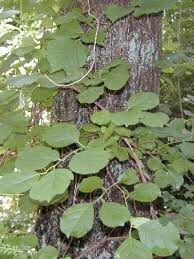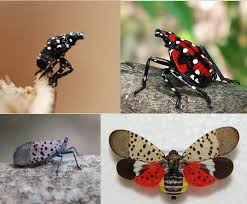Hemp Dogbane
Very invasive and toxic to livestock
Discovered in Farmcolony’s hay fields, mainly pasture H3

Hemp dogbane is a very invasive herb in the milkweed family considered highly toxic to humans and mammals. All parts of this plant exude a milky juice when bruised and all plant parts are toxic to livestock. The plant has infested a large portion of our H3 pasture and is being treated with herbicide. Smaller amounts have been pulled in another pasture.
The hemp portion of its common name comes from the fact that Indians used fiber crushed out of the stems and roots of the plant to make rope and clothing. The woody bark became material for baskets. Ancient medicine used it as a sedative and treatment for syphilis, worms, fever, rheumatism and more. In more modern applications, it is harvested in fall for string and cordage. Today, it is mostly known as an agricultural pest.
Although Hemp Dogbane looks strikingly similar to common milkweed, it is not a host to monarch butterflies. It reproduces by seeds, but the primary mode of reproduction of plants is by way of their creeping roots that can burrow 6 feet into the earth. Patches of hemp dogbane are capable of doubling in size during one growing season.
Dogbane is often difficult to distinguish from milkweed. The Monarch Joint Venture, an organization that works to conserve the monarch migration, points out the following ways the plants are similar, and how to tell them apart.
Similarities: Both plants have milky sap if you break off a leaf, and their growth pattern is very similar. Both have opposite and oval shaped leaves.
Differences: Dogbane is a stout perennial with a woody stem that is undivided at the base but becomes much-branched in its upper half whereas Common Milkweed has no branches. Dogbane has more of a reddish stem when mature and the stems are smooth rather than hairy. The flowers also look quite different. Common milkweed flowers are pinkish, large and ball shaped and arranged in a spherical pattern, whereas dogbane flowers are whitish green typically with a flatter, disc-like arrangement that form in clusters located at the ends of main stems and primary branches. Fruits are distinctive 4- to 8-inch-long pods that generally occur in pairs.
As with most toxic plants, livestock do not readily consume milkweed or dogbane unless it is the only forage available. The risk for poisoning increases when fields are overgrazed or dormant, such as during mid-summer. Perhaps the highest risk for poisoning is from contaminated hay simply because it can be difficult to tell that toxic plants are present.
Early control is important with dogbane because the seeds travel easily with the wind which can result in these weeds spreading quickly. Mowing can prevent the plants from going to seed, but because they have a well-established root system they will often recover. Herbicides are usually the most effective way to control dogbane.
We can be thankful for the keen eyes of our hay committee for spotting and working to eradicate this scourge from our fields.
ORIENTAL BITTERSWEET
Murders Forests, Strangles Trees, Smothers Understory and is spreading profusely near the cul-de-sac on Colony Drive

Don’t let looks fool you! This beautiful exotic vine boasts golden fall color and brightly colored berries that are showy from fall into winter, but, as the Blue Ridge Partnership for Regional Invasive Species Management warns, the Oriental Bittersweet climbs high into the trees strangling and toppling anything in its path, and smothers underlying shrubs, wildflowers and future tree generations on the ground. It scatters its seeds far and wide with the help of wildlife and people.
First introduced to the U.S. from Asia in the 1860’s as an ornamental garden plant, it quickly escaped from gardens. This invasive vine now infests the eastern U.S. from Maine through Georgia and west to Wisconsin and Missouri. It has been a serious pest in New England since the 1970’s.
Blue Ridge Partnership, www.blueridgeprism.org, offers the following tips on controlling Oriental Bittersweet.
Search and Destroy: Look for bittersweet high up in the tree canopy and on the forest floor. Bittersweet leaves stay green in fall after most native plants have changed color or dropped their leaves, then turn yellow when most plants are leafless. If you search for bittersweet in fall, infestations are easy to spot and can be treated then.
Manual & Mechanical: You can destroy small bittersweet vines by hand pulling, but be sure to remove the crown and all large roots, or vigorous new growth will occur. Do not pull vines from trees; this is hazardous to people on the ground and can harm the trees.
Cut Stump: Cut small to large vines near ground level, using a clipper, hand-saw or chainsaw. To prevent re-sprouting, immediately apply a concentrated herbicide to the cut stump or apply a foliar spray to the regrowth a month later.
Foliar Spray: Low bushy vines or re-sprouted vines can be killed with a foliar herbicide spray from spring through fall. (It is best not to spray large vines, but to cut stump them.) To avoid harming desirable plants, apply foliar sprays when other plants are leafless in late fall, but while bittersweet leaves are still green. If your chosen herbicide product does not contain a surfactant, add one. To ensure long-term control of Oriental bittersweet, monitor treated sites for several years for seedlings and regrowth from roots; treat these as soon as possible.
Spotted Lantern Fly
And Watch Out for this Invasive Pest
Extremely damaging to the grape, orchard, and logging industry

The Virginia Cooperative Extension has warned that the Spotted Lanternfly, a potentially serious pest of grapes, peaches, hops, and a variety of other crops, was detected in Frederick County, Virginia, on Jan. 10, 2018. An invasive species native to China, Bangladesh, and Vietnam, the Spotted Lanternfly was first discovered in Pennsylvania in 2014 and has since spread to 26 counties which are now quarantined. It is important to look for it and report any finds.
The Spotted Lanternfly attacks tree fruits, grapes, hops and over 70 other trees and plants. Damage in trees includes oozing sap, wilting, leaf curling, and tree dieback. In addition to tree damage, when spotted lanternflies feed, they excrete a sugary substance, called honeydew, that encourages the growth of a black sooty mold that covers branches, trunks, and anything under an infested tree making it appear like a fire has scorched the area. Some of the honeydew will ferment leaving a vinegar smell.
The black mold is harmless to people, however it causes damage to plants. In counties infested and quarantined for Spotted Lanternfly, residents report that hundreds of these bad bugs affect their quality of life and ability to enjoy the outdoors during the spring and summer months. Spotted Lanternflies will cover trees, swarm in the air, and their sooty mold can coat decks and play equipment.
In addition to damaging trees and affecting quality of life, the Spotted Lanternfly is a huge threat to the agriculture industry. They threaten billions in economic impact and hundreds of thousands of jobs for those in the grapes, apple, hops, and hardwood industries.
Signs and symptoms:
- Plants that ooze or weep and have a fermented odor
- Buildup of sticky fluid (honeydew) on plants and on the ground underneath infested plants
- Sooty mold on infested plants
Spotted Lanternflies prefer feeding on Ailanthus altissima, commonly known as the “Tree of Heaven.” They can be found feeding on other plants and trees, but Ailanthus altissima is their favorite host.
If you find an insect that you suspect is the Spotted Lanternfly, please report it to the following experts to have the specimen identified properly.
These are called bad bugs for a reason.


